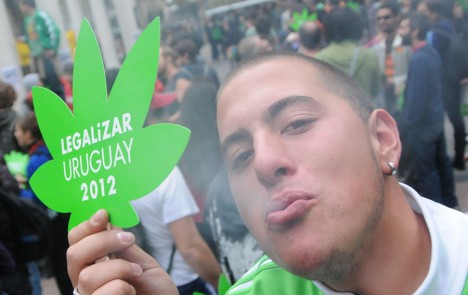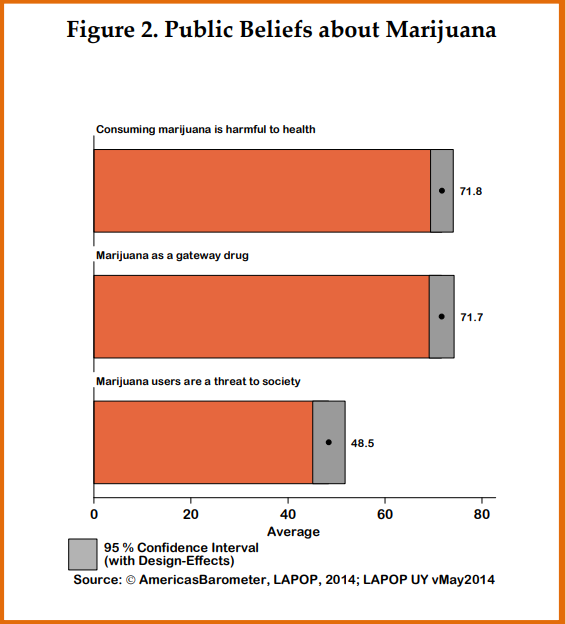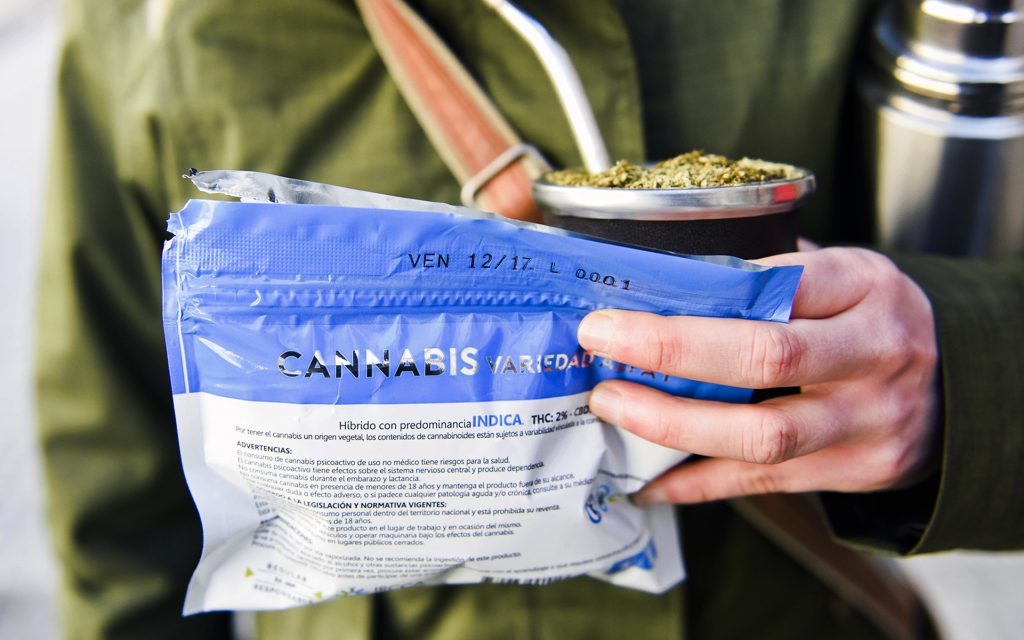INTRODUCTION
 In 2013, Uruguay became the first country in fully regulating the marijuana market that now operates under state control.
In 2013, Uruguay became the first country in fully regulating the marijuana market that now operates under state control.
In a Washington Post feature article on Uruguay’s cannabis laws, they reported that Uruguay is socially liberal and has a wide separation of church and state. Gambling and prostitution are legal and regulated. Uruguay is also the only Latin American nation outside Cuba that has broadly legalised abortion, and it was one of the first to recognize civil unions and adoption by same-sex couples. Uruguay also is accustomed to relatively high levels of regulation and a big state role in the economy, with an array of government-owned banks, gas stations and utilities. Over the years, activists began to argue: Why not weed? [1]
As early as 1974, Uruguay decriminalised possession of “a minimum quantity [of illicit substances], intended solely for personal use.” Exactly what constituted a “minimum quantity” was never clarified, giving judges broad discretion in its interpretation.
The initiative of marijuana regulation was by the then president José Mujica. Lawmakers in Uruguay (population: 3.3m) signed the country’s cannabis bill into law in December 2013 and pharmacies began selling two strains of legal marijuana cultivated by two government-authorised firms in July 2017.
The text of the law expresses its goals through three main objectives, which included reducing drug trafficking-related violence by taking cannabis off the black market[2], and promoting public health through education and prevention campaigns, thereby “minimising the risks and reducing the harm of cannabis use”[3].
Uruguay was the first country to leave behind the global ban on non-medical cannabis that began with the United Nations’ 1961 Single Convention on Narcotic Drugs, and despite repeated criticisms from the International Narcotics Control Board (INCB), as in the Board’s report for 2016, which states:
The Board notes the continued implementation by the Government of Uruguay of measures aimed at creating a regulated market for the non-medical use of cannabis… [T]he Board wishes to reiterate its position that such legislation is contrary to the provisions of the international drug control conventions… according to which States parties are obliged to ‘limit exclusively to medical and scientific purposes the production, manufacture, export, import, distribution of, trade in, use and possession of drugs.’[4]
Concerned that their policy would come under intense scrutiny from their neighbours and from the broader international community, Uruguayan authorities deliberately opted for a strict approach to regulation, such as a user registry and monthly sales limits. [5]
In an attempt to reassure the international public opinion, President José Mujica, said that his government would not allow unlimited use of marijuana and illicit drug dealing: “And if somebody buys 20 marijuana cigarettes, he will have to smoke them. He won’t be able to sell them“.[6]
And in order to convince the majority of the Uruguayan population, the President Mujica promised to launch at the same time “a campaign aimed at young people on how to consume marijuana. Avoid, for example, to smoke to not damage the lungs but inhale or consume it with food“.[7]
In response to public opposition, the Open Society Foundation headed by the financier George Soros announced the launch of a massive media campaign across the nation to manipulate the public consensus. Time magazine (5 Aug 2013) reported that “a massive media campaign, with television ads funded partly by Soros’ Open Society Foundations group, were required to convince opponents of legalisation”.[8] [9]
STATE CONTROL – HOW IT WORKS
There are three ways to legally obtain cannabis in Uruguay.[10] The first alternative is autocultivo, which allows individuals to grow up to six marijuana plants per household and yield an annual crop of 480 grams per year, or 40 grams per month. All individuals must register with the government agency for the regulation and control of cannabis—called the Instituto de Regulación y Control de Cannabis (Cannabis Regulation and Control Institute) to grow these plants in their home and no person may register more than one location for domestic growth. The second alternative is the Cannabis Club, which allows between 15 to 45 members of a duly-registered civil association to farm up to 99 marijuana plants in specific locations. Each club may not supply any individual with more than 480 grams of marijuana per year. The third alternative is sale through pharmacies. This alternative will allow a registered consumer to buy up to 40 grams of marijuana per month and 480 per year in person from pharmacies that are registered with the IRCCA and the Ministry of Public Health. On July 19, 2017, Uruguay launched the last remaining stage of the cannabis law, with sales finally beginning in 16 pharmacies across the country.
PUBLIC DISAPPROVAL
Public opinion surveys have consistently shown most Uruguayans to be doubtful about the government’s initiative.[11]
According to the results of the 2014 AmericasBarometer survey in Uruguay, only 34% of Uruguayans approved the new regulations regarding the liberalization of marijuana use, while 60.7% showed their disapproval to the new policies. Perhaps not surprisingly, approval for the new regulation of cannabis is closely related to previous personal experimentation with marijuana and a history of marijuana consumption among relatives and close friends.
 PUBLIC SKEPTICISM
PUBLIC SKEPTICISM
As of 2014, most Uruguayans remained skeptical about the benefits the new regulation will bring. For instance, 42% of Uruguayans considered that the general situation of the country would worsen as a result of regulation, while only 19% believed that the situation would improve. Among the most negative opinions expressed, 70% of Uruguayans stated that public safety and public health conditions would either worsen or remain the same. The issue that seemed to generate the most positive opinions was related to the fight against drug trafficking organisations.
 Source: https://www.vanderbilt.edu/lapop/insights/ITB020en.pdf
Source: https://www.vanderbilt.edu/lapop/insights/ITB020en.pdf
PUBLIC USAGE
In 2001, 5.3% of the population admitted to having consumed marijuana.
By 2014, life prevalence had quadrupled with 22.1% of Uruguayans acknowledging some consumption.[12]
Since Uruguay legalised the sale of marijuana, underage use increased from 14% to 21%. Use by those aged 19 to 24 increased from 23% to 36% Those aged 25 to 34 increased from 15% to 25%.
Source: https://wdr.unodc.org/wdr2019/prelaunch/WDR19_Booklet_5_CANNABIS_HALLUCINOGENS.pdf
TEENS
Prevalence doubled among secondary school students from 2003 to 2014. In 2003, 8.4% of students had consumed marijuana during the previous twelve months. in 2014, 17% had.[13]
Almost a quarter of the high-frequency users of Montevideo had their first experience with marijuana before age turning 15 (24.1%).[14]
Prevalence is also higher among 18-25 year-olds than other age categories.
 NON-COMPLIANCE
NON-COMPLIANCE
As at February 2018, 8,125 individuals and 78 cannabis clubs with a total of 2,049 members were registered in addition to the 20,900 people registered through pharmacy sales for cannabis. The system potentially provides cannabis to around 30,000 of the 140,000 past-month cannabis users estimated in Uruguay in 2014.[15]
A recent survey found that almost 40% said they would probably or definitely flout the law which requires registration. (19.6% state that it is not probable that they will register, and another 19.6% said that they are certain that they will not register.) [16]
MONITORING AND EVALUATION
A 2018 Brookings Institute report details how the Ministerio de Salud Pública is required to submit an annual report on the impacts of the legalization since 2014 – but the ministry has only submitted such a report once, in 2016, and the findings were not made public.[17] [18]
According to a report by WOLA (funded by Open Society Foundations – aka George Soros) and posted on the Monitor Cannabis Uruguay site[19], in spite of President Vázquez’s support for monitoring and evaluation, his administration has provided the public with relatively little in the way of hard data on the early effects of initial implementation of the cannabis measure.[20]
The IRCCA’s limited staff – it has a team of six inspectors who are responsible for ensuring compliance[21] – does not realistically allow the institute to check the annual plant yields for all 8,000+ homegrowers and approximately 80 registered clubs.[22]
PRODUCTS
A recent study of marijuana consumers in Montevideo found that users had consumed it in several different ways during the past year, including vaporizers (15.7%), edibles, such as brownies, cakes, cookies (26.4%), and drinks, such as mate, milkshakes, daiquiris (9.4%).[23]
PERCEPTION OF RISK
The study of marijuana consumers in Montevideo also found that users had a very low perception of risk associated with undertaking several activities while under the influence of marijuana. For instance: 21.4% of respondents drove a car under the influence of marijuana; 28.4% rode a motorcycle; 11.2% operated heavy equipment. More than half of the respondents (55.4%) declared that they consumed marijuana and went to work before four hours had passed.
More than one in every four of those women who were pregnant (26.1%) reported to having continued consuming marijuana while pregnant.[24]
BLACK MARKET
Three years after legalisation, seven out of every ten cannabis consumers still acquire the product on the black market. Authorities admit that “street selling points have multiplied in recent years, along with criminal acts related to micro trafficking.”[25]
Marcos Baudeán, a member of the study group Monitor Cannabis Uruguay, suggests it may be worse than that: “Consider the fact that there are 55,000 regular consumers who are responsible for 80% of the marijuana consumption in the country, but currently only 10% are consuming from the legal market, the rest are buying the drug off the illegal market.” [26]
Others have pointed to the very low concentration of THC in the legal drug as another reason why some users may turn to the black market.[27] Though the price may be higher — a gram of high-potency illegal marijuana can cost as much as $20[28] — some users may be willing to pay this premium in exchange for access to a more powerful drug.[29]
Because sales to tourists are prohibited, some Uruguayan homegrowers and clubs have attempted to get around the ban by offering ‘cannabis tours’, which are framed more as social and educational experiences, in which participants are free to sample cannabis while on a paid tour. Others simply sell directly to tourists behind closed doors, a grey market quietly operating via word of mouth.[30]
FINANCIAL IMPLICATIONS
An unexpected consequence of Uruguay’s marijuana law is that the U.S. government invoked the Patriot Act which prohibits U.S. banks from handling funds for distributors of marijuana. In Uruguay, this is by way of the pharmacies only. International banks – both those with U.S. headquarters such as Citibank and European banks such as Santander have advised their Uruguayan branches that they are prohibited from providing services to the distributors of marijuana.
As a result, pharmacies tasked with the sale and distribution of marijuana have been cut off from the entire financial services market because the banks in Uruguay announced that every business associated with the newly legal marijuana industry risked being in violation of the U.S. drug laws and would lose their access to U.S. banks and dollar transactions.
SUMMARY
 What we have learned from the data so far indicates that frequency of consumption has significantly increased, especially in the 15-24 age group. The perception of risk with drug use is low, and risky behaviours have increased with the frequency of consumption, including use of marijuana during pregnancy. The black market is alive and well. And the overwhelming support for the regulation among high-frequency marijuana users does not immediately translate into willingness to comply with it. Of most concern is that monitoring and reporting of the effects of legalisation is minimal, and not made public.
What we have learned from the data so far indicates that frequency of consumption has significantly increased, especially in the 15-24 age group. The perception of risk with drug use is low, and risky behaviours have increased with the frequency of consumption, including use of marijuana during pregnancy. The black market is alive and well. And the overwhelming support for the regulation among high-frequency marijuana users does not immediately translate into willingness to comply with it. Of most concern is that monitoring and reporting of the effects of legalisation is minimal, and not made public.
The drug-friendly website CannabisWire in July 2018 summed it up perfectly. “What Have We Learned From the First Nation to Legalize Cannabis? Not Enough.” [31]
[1] https://www.washingtonpost.com/world/the_americas/in-uruguays-marijuana-experiment-the-government-is-your-pot-dealer/2017/07/07/6212360c-5a88-11e7-aa69-3964a7d55207_story.html?utm_term=.c5f59831c07f
[2] Article 4 of Law 19172
[3] Article 1 of Law 19172
[4] International Narcotics Control Board. Report of the International Narcotics Control Board for 2016. United Nations.
(2017). https://www.incb.org/documents/Publications/AnnualReports/AR2016/English/AR2016_E_ebook.pdf
[5] Source: https://www.brookings.edu/wp-content/uploads/2018/03/gs_032118_uruguaye28099s-cannabis-law_final.pdf
[6] https://www.telegraph.co.uk/news/worldnews/southamerica/uruguay/9347452/Uruguay-marijuana-sales-to-be-controlled-by-state.html
[7] https://www.lastampa.it/2013/02/21/esteri/l-ultima-sfida-del-presidente-mujica-vi-insegno-come-usare-la-marijuana-9DqZIHKyZ7zAX1sA3cAL3K/pagina.html
[8] http://world.time.com/2013/08/05/high-times-in-montevideo-uruguay-enters-brave-new-world-of-pot-legalization/#ixzz2bTb9RI9C
[9] http://www.ecad.net/images/stories/uruguay_cannabis_tupamaros.pdf
[10] Source: https://lacc.fiu.edu/events/2015/marijuana-legalization-in-uruguay-and-beyond/14561_sipa_marijuana-research_report2-1.pdf
[11] El consumo de marihuana y su venta en farmacias. CIFRA / González, Raga & Asociados. (2017, August 17). http://www.cifra.com.uy/index.php/2017/08/17/el-consumo-de-marihuana-y-su-venta-en-farmacias-2/
[12] “5ta Encuesta nacional en hogares sobre consumo de drogas” Junta Nacional de Drogas. Montevideo, 2012, and AmericasBarometer 2014
[13] “6ta Encuesta nacional sobre consumo de drogas en estudiantes de educación media” Junta Nacional de Drogas. Montevideo, 2014.
[14] https://pdfs.semanticscholar.org/958c/f0797e72255c860618a19
[15] https://www.unodc.org/pdf/opioids-crisis/WDR18_Booklet_3_DRUG_MARKETS.PDF
[16] https://lacc.fiu.edu/events/2015/marijuana-legalization-in-uruguay-and-beyond/14561_sipa_marijuana-research_report2-1.pdf
[17] Article 42 of Law 19172
[18] https://www.brookings.edu/wp-content/uploads/2018/03/gs_032118_uruguaye28099s-cannabis-law_final.pdf
[19] http://monitorcannabis.uy/en/
[20] https://www.wola.org/wp-content/uploads/2016/09/Getting-Regulation-Right-WOLA-Uruguay.pdf
[21] Bello, C. Gobierno salió a fiscalizar a fin de evitar el turismo cannábico. El Observador. (2018, January 2).
https://www.elobservador.com.uy/gobierno-salio-fiscalizar-fin-evitar-el-turismo-cannabico-n1155653
[22] https://www.brookings.edu/wp-content/uploads/2018/03/gs_032118_uruguaye28099s-cannabis-law_final.pdf
[23] https://pdfs.semanticscholar.org/958c/f0797e72255c860618a19a49c440db258d77.pdf
[24] https://pdfs.semanticscholar.org/958c/f0797e72255c860618a19a49c440db258d77.pdf
[25] https://www.minterior.gub.uy/index.php/component/content/article/78-noticias/ultimas-noticias/4010-marihuana-incautada-supera-valores-de-2015
[26] https://www.insightcrime.org/news/analysis/delay-marijuana-law-uruguay-leaves-door-ajar-drug-trafficking/
[27] https://www.infobae.com/america/america-latina/2017/07/16/nuevo-debate-en-uruguay-la-marihuana-de-las-farmacias-es-demasiado-suave-para-el-consumidor-habitual/
[28] https://www.insightcrime.org/news/analysis/delay-marijuana-law-uruguay-leaves-door-ajar-drug-trafficking/
[29] https://www.insightcrime.org/news/brief/marijuana-sales-legal-uruguay-pharmacies/
[30] https://www.brookings.edu/wp-content/uploads/2018/03/gs_032118_uruguaye28099s-cannabis-law_final.pdf
[31] https://cannabiswire.com/2018/07/06/what-have-we-learned-from-the-first-nation-to-legalize-cannabis-not-enough/


